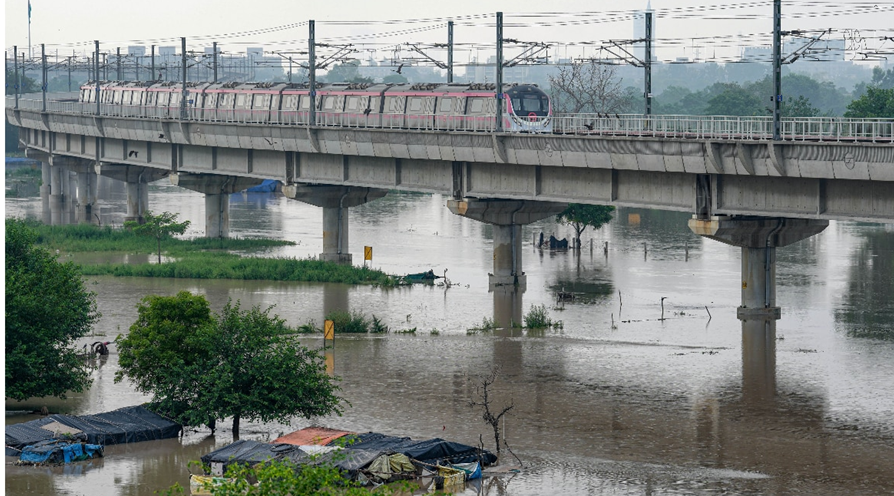Description

Copyright infringement not intended
Context: The heavy rainfall in Delhi and nearby regions, along with the release of water from Hathni Kund Barrage, has increased the possibility of flooding in low-lying areas near the river. The Delhi Police has enforced restrictions under CrPC section 144 in the areas that are vulnerable to floods.
Details
- The Yamuna River in Delhi has reached a record level of 207.81 metres, surpassing the previous highest mark of 207.49 metres in 1978.
- The heavy rainfall in Delhi and nearby regions, along with the discharge of water from Hathni Kund Barrage, has increased the possibility of flooding in low-lying areas near the river. As a result, the Delhi Police issued a notice earlier today (July 12) that it has enforced restrictions under CrPC section 144 in flood-prone areas of the city.
What is Section 144?
- Section 144 of CrPC (Code of Criminal Procedure) is a law that was inherited from colonial times and gives the power to a district magistrate, a sub-divisional magistrate or any other executive magistrate authorized by the state government to issue orders to prevent and deal with situations of imminent danger or nuisance.
- The order has to be in writing and can be directed against a specific person or to people living in a specific place or area, or to the general public when they frequent or visit a specific place or area. In urgent cases, the order can be passed without giving prior notice to the person who is affected by the order.
Powers of administration under the provision
- Section 144 of the Code of Criminal Procedure empowers the authorities to issue orders to prevent or control any situation that may cause public nuisance, danger, riot or violence.
- The order can be applied to a specific person or a group of people, and it can prohibit them from doing certain things or require them to do certain things related to their property or activities.
- For example, the order can ban people from gathering in a place, carrying weapons or disrupting public order. The order is meant to protect the rights and safety of other people who are lawfully engaged in their work or duties.
- The order can only be issued when the magistrate is satisfied that there is sufficient ground for immediate action, and that such action is necessary to prevent harm or disturbance.
- The order cannot last for more than two months unless the state government extends it for a valid reason. However, the maximum duration of the order cannot exceed six months.

When is Section 144 imposed?
- Section 144 is a legal provision that empowers the authorities to impose restrictions on the movement, assembly, or activities of people in a certain area or time. It is meant to prevent any possible danger to public peace and order. However, the section is often criticized for being vague, arbitrary, and prone to misuse.
- A recent study by some lawyers analyzed more than 5,000 orders issued by the Delhi Police under Section 144 in one year. They found that the section was used for various purposes, ranging from installing CCTV cameras to banning a type of kite string. Only a small fraction of the orders prohibited unlawful assembly, which is the main objective of the section.
- The study highlighted the need for more transparency, accountability, and judicial oversight in the use of Section 144. It also suggested that the section should be invoked only in exceptional circumstances, and not as a routine measure to curb civil liberties.
Section 144 imposed in Delhi?
- Due to the heavy rainfall and flooding in Delhi, Section 144 has been imposed in some low-lying and vulnerable areas of the city. The purpose of this measure is to prevent any untoward incidents, such as drowning, electrocution, or property damage, that may occur due to the flood situation.
- This is not a new or unusual step taken by the government. In the past, Section 144 has been imposed in various parts of the country when there was a risk of natural disasters, such as landslides, cyclones, or earthquakes.
- For instance, in 2016, Section 144 was imposed near Hero Honda Chowk in Gurgaon after heavy rains caused severe water-logging and traffic jams on the expressway.
- Section 144 was imposed in Kaziranga National Park in Assam yesterday to protect wildlife from human interference during the monsoon season. The order prohibits any gathering or movement of people near the animal corridors, where many animals cross over to higher grounds to escape the floods.
- Section 144 is a temporary and precautionary measure that is meant to ensure the safety and security of both people and animals during times of crisis. It is not a violation of any fundamental rights or freedoms, but rather a reasonable restriction imposed in the public interest.
Must-Read Articles:
Floods: https://www.iasgyan.in/daily-current-affairs/floods
Flash Floods: https://www.iasgyan.in/daily-current-affairs/flash-floods-28
|
PRACTICE QUESTION
Q. Floods are one of the most common and devastating natural disasters that affect millions of people around the world every year. What are the main causes of floods and how do they impact the environment, society and economy? What are the challenges faced by governments, communities and individuals in coping with and recovering from floods? What are some of the possible solutions or strategies to prevent or mitigate the effects of floods in the future?
|

https://indianexpress.com/article/explained/everyday-explainers/delhi-police-prohibitory-orders-section-144-flood-8831180/















